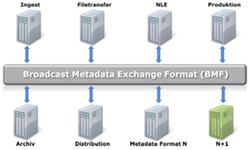
The Institut für Rundfunktechnik (IRT) has published the Broadcast Metadata Exchange Format (BMF) in the official version 2.0. BMF 2.0 is a manufacturer-independent format and enables a continuous exchange of metadata in radio, television and internet sectors. This reduces both costs and risks when integrating interfaces in an IT-based production environment.
Together with working groups of the German public broadcasters of ARD and ZDF, BMF 2.0, in comparison to the previous version, was substantially extended, the user friendliness was improved, and a process for flexibly generating subsets of the BMF model was developed. Manufacturers and systems integrators can use the published BMF 2.0 format for unifying the metadata exchange in their products.
The basics for the extension of BMF to version 2.0 were developed within the framework of the research project CONTENTUS and were supported by the German Federal Ministry of Economy in the frame of the Theseus programme.
BMF 2.0 will be showcased at the IBM booth (N5223) at NAB 2012 in the frame of a proof of concept implemented together with the manufactures Annova, arvato Systems, IBM and IRT.
For the technical use of BMF 2.0, IRT assists its associates and customers with suitable services, as the analysis of use cases, the generation of BMF subschemes for the implementation, as well as the metadata mapping.
BMF 2.0 facilitates the reuse of metadata and increases the interoperability between IT systems. The BMF model covers the information requirements from television production, planning, distribution, and archiving. This is the result of a thorough evaluation of different use cases, which was accomplished in close collaboration with working groups of public broadcasters in Germany. Furthermore the requirements, which were developed within the framework of the research project CONTENTUS, were incorporated in BMF 2.0. For example, it enables the employment of BMF for production, programme, and event planning. Further, support of annotation, camera metadata, and the order as well as the transfer of programme material via file transfer is considered by BMF 2.0.







